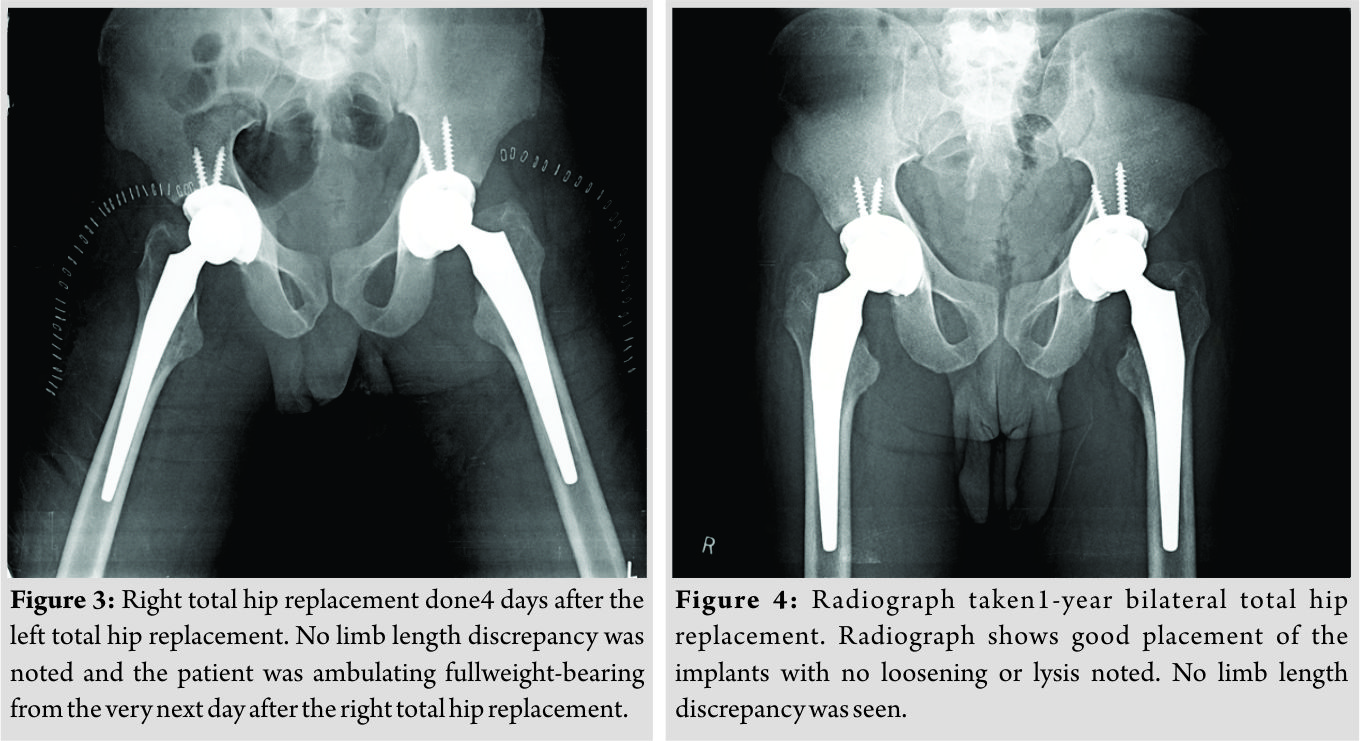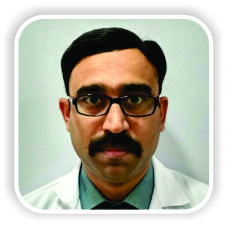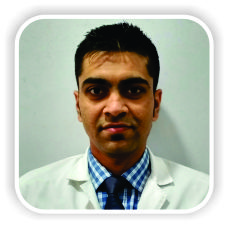[box type=”bio”] Learning Point of the Article: [/box]
From this case report, we conclude that Ayurvedic medications are responsible for accelerated osteoporosis, leading to atraumatic fracture.
Case Report | Volume 9 | Issue 1 | JOCR January – February 2019 | Page 45-48 | Sharath Kittanakere Ramanath, Rahul Hemant Shah, Y Karthik Pradyumna. DOI: 10.13107/jocr.2250-0685.1302
Authors: Sharath Kittanakere Ramanath[1], Rahul Hemant Shah[1], Y Karthik Pradyumna[1]
[1]Department of Orthopaedics, Ramaiah Medical College and Hospitals, Bengaluru, Karnataka, India.
Address of Correspondence:
Dr. Rahul Hemant Shah,
Department of Orthopaedics, Ramaiah Medical College and Hospitals, Bengaluru – 560054, Karnataka, India.
E-mail: rahul54shah@gmail.com
Abstract
Introduction: In chronic renal failure, plasma 1,25-hydroxyvitamin D levels decrease due to the disturbance of the hydroxylation of 25-hydroxyvitamin D in the kidney, which results in decreased calcium absorption from the intestine. This induces hypocalcemia, which increases the secretion of parathyroid hormone. Parathyroid hormone can stimulate bone resorption which renders the bone susceptible to fractures even with trivial trauma.
Case Report: The present case describes a 41-year-old male who was diagnosed with chronic kidney disease for 6 months and started taking Ayurvedic medications after the diagnosis was established. The patient was a known hypertensive for 10 years and the patient was not taking medications for hypertension. The patient had a trivial trauma 2 months back following which he was able to walk and carry out his daily activities. He developed pain over both the hip joints which were gradually progressive and pain increased to the point, wherein the patient was unable to walk 1 month after the episode of trivial trauma. The patient was admitted for inability to walk and a radiographic study of the pelvis revealed bilateral femur neck fracture. Since the left hip was more symptomatic, the patient underwent total hip replacement of the left hip first following which total hip replacement of the right hip was done 4 days after the first surgery. The patient started ambulating full-weight-bearing with the help of a height adjustable walker from the very next day after total hip replacement of the right hip.
Conclusion: Although Ayurvedic medications have been in practice since centuries, their side effects need to be documented correctly. This particular case suggests the role of Ayurvedic medications in accelerating osteoporosis of the proximal femur, leading to bilateral femur neck fractures.
Keywords: Femur neck, total hip replacement, arthroplasty, Ayurvedic medications, chronic kidney disease, atraumatic.
Introduction
In chronic renal failure, plasma 1, 25-hydroxyvitamin D levels decrease due to the disturbance of hydroxylation of 25-hydroxyvitamin D in the kidney, which results in decreased calcium absorption from the intestine. This induces hypocalcemia, which increases the secretion of parathyroid hormone. Parathyroid hormone can stimulate bone resorption [1, 2]. The occurrence of bilateral femur fractures is rare and it is extremely rare in young adult males. Chronic kidney disease (CKD) leads to renal osteodystrophy which reduces bone strength and can either be asymptomatic or can lead to osteoarticular pain, bone deformation, and fractures [3]. We present a case of bilateral femur neck fracture following trivial trauma in a young adult Indian male on Ayurvedic medications for CKD which has not been reported in literature before.
Case Report
A 41-year-old was admitted in view of inability to walk due to bilateral hip pain. The patient was a known hypertensive for10 years and had not taken medications for hypertension. 6 months before admission, the patient was diagnosed with CKD for which patient started taking Ayurvedic medication. The medication which the patient was taking contained Ashwagandha, saliva, Jeeraka, Madhusnuhi, Daksha, and Ela. The patient did not follow-up. 4 months after being diagnosed with CKD, the patient had a self-fall following which the patient was able to walk and carry out his daily activities. The patient started developing pain over both the hip joints 1 week after the fall. Pain was dull aching in nature and it was of mild intensity. Pain did not hamper patient’s daily activities in any manner whatsoever. However, 1 month after the fall, the pain increased in severity to the point where the patient was unable to walk and had to seek inpatient treatment. Standard radiographs of the pelvis revealed bilateral femur neck fracture (Fig. 1). Routine blood investigations were done. The patient was found to be anemic with an hemoglobin of 9.3 gm/dl on admission which was corrected to 12.5 gm/dl before the surgery by blood transfusion. Total leukocyte counts were normal. Serum creatinine was 13.27 mg/dl to begin with and it was reduced to 3.91 after 3 weeks of admission. Serum calcium was 6.75 mg/dl. No dyselectrolytemia was noted. 3 weeks after the admission, the patient was deemed fit for surgery. The patient was planned for left hip total hip replacement (Fig. 2) since the left hip was more symptomatic than the right hip. 4 days after the left total hip replacement, the right total hip replacement was done (Fig. 3). The patient started walking full weight-bearing with the help of a height adjustable walker from the very next day after the right total hip replacement. At 1-year follow-up after the surgery, the patient was able to carry out his daily activities without any difficulty. Implants were well in position with no loosening or lysis noted (Fig. 4). Renal disease/chronic renal failure is a proven cause for osteoporosis, leading to pathological fractures. There have been very few cases of pathological femur neck fractures in patients of kidney disease. However, no case has been reported until date where a pathological femur neck fracture was caused within 6 months of the onset of chronic renal failure/kidney disease. This is what makes the case so unique. Hence, we can decipher from the fact that Ayurvedic medications have some contents which accelerate osteoporosis. Ayurvedic medications along with renal failure might have probably worked in a synergistic way to accelerate osteoporosis. This warrants further investigation into the composition of Ayurvedic medications. No case has been reported until date where chronic renal failure of 6 months duration has caused pathological fracture in the femoral neck. Serum blood urea nitrogen was 87.2 mg/dl (elevated) which was normalized to 17.3 mg/dl preoperatively. The patient underwent dialysis 4 times after which the blood parameters normalized following which the patient was taken up for surgery. Ayurveda is a system of medicine with historical roots in the Indian subcontinent. Although laboratory experiments suggest that it is possible that some substances used in Ayurveda might be developed into effective treatments, there is no scientific evidence about their medical efficacy.
Routine blood investigations were done. The patient was found to be anemic with an hemoglobin of 9.3 gm/dl on admission which was corrected to 12.5 gm/dl before the surgery by blood transfusion. Total leukocyte counts were normal. Serum creatinine was 13.27 mg/dl to begin with and it was reduced to 3.91 after 3 weeks of admission. Serum calcium was 6.75 mg/dl. No dyselectrolytemia was noted. 3 weeks after the admission, the patient was deemed fit for surgery. The patient was planned for left hip total hip replacement (Fig. 2) since the left hip was more symptomatic than the right hip. 4 days after the left total hip replacement, the right total hip replacement was done (Fig. 3). The patient started walking full weight-bearing with the help of a height adjustable walker from the very next day after the right total hip replacement. At 1-year follow-up after the surgery, the patient was able to carry out his daily activities without any difficulty. Implants were well in position with no loosening or lysis noted (Fig. 4). Renal disease/chronic renal failure is a proven cause for osteoporosis, leading to pathological fractures. There have been very few cases of pathological femur neck fractures in patients of kidney disease. However, no case has been reported until date where a pathological femur neck fracture was caused within 6 months of the onset of chronic renal failure/kidney disease. This is what makes the case so unique. Hence, we can decipher from the fact that Ayurvedic medications have some contents which accelerate osteoporosis. Ayurvedic medications along with renal failure might have probably worked in a synergistic way to accelerate osteoporosis. This warrants further investigation into the composition of Ayurvedic medications. No case has been reported until date where chronic renal failure of 6 months duration has caused pathological fracture in the femoral neck. Serum blood urea nitrogen was 87.2 mg/dl (elevated) which was normalized to 17.3 mg/dl preoperatively. The patient underwent dialysis 4 times after which the blood parameters normalized following which the patient was taken up for surgery. Ayurveda is a system of medicine with historical roots in the Indian subcontinent. Although laboratory experiments suggest that it is possible that some substances used in Ayurveda might be developed into effective treatments, there is no scientific evidence about their medical efficacy.
Discussion
Bilateral femoral neck fracture has been reported to be the result of high-energy trauma, high-voltage electrical injury, abnormal anatomy, chronic renal failure, and associated with primary and secondary bone disease such as osteomalacia. In the elderly population, simple trip and fall can lead to bilateral hip injury [4]. Renal osteodystrophy encompasses a number of skeletal abnormalities including osteitis fibrosa, osteomalacia, hyperosteidosis, osteosclerosis, and several types of developmental problems in children [5]. Although the occurrence of fractures in patients with skeletal abnormalities has been established [5], pathologic fracture of the femoral neck [6] is rare and bilateral occurrence is all the more uncommon. Phosphate retention is noted in renal osteodystrophy. Decreased tubular filtration of phosphate combined with increased serum phosphate concentration causes a decrease in 1, 25-dihydroxyvitamin D synthesis. This decreases calcium absorption from the gastrointestinal tract. This causes marked secondary hyperparathyroidism and the serum calcium levels rise partially at the expense of the bones [7]. In the treatment of hip fractures in patients with renal failure, recent reports favored operative treatment. Schaab et al. [8] reported 11 cases of femoral neck fracture in 11 patients with chronic renal failure, seven of whom underwent operations. Morbidity and mortality were analyzed to compare operative and conservative management of femoral neck fractures in dialysis patients. All fractures occurred in older individuals, who had been dependent on dialysis for an average of 9.2 years. Operative management was found to be superior to conservative treatment as far as complications and mortality rates were concerned. Klein et al. [9] reported the first year mortality after surgical treatment of hip fractures in patients with renal failure to be 38%. That study included nine fractures in eight patients with an average age of 63 years; six patients were dependent on dialysis and two patients had functioning renal transplants. The authors stated that operative treatment and aggressive mobilization allow patients with renal failure to regain ambulation and return to the level of independence they had before their hip fracture and to avoid skin breakdown. Hernigou et al. reported a case of 38-year-old woman who developed bilateral simultaneous femoral neck stress fractures after recovering from anorexia nervosa. The patient was managed with dynamic hip screw bilaterally [10]. Unlike this case, our case had bilaterally displaced femur neck fracture which was managed with bilateral total hip arthroplasty in two sittings. Nakanishi et al. conducted a study on 293 patients on chronic dialysis. Their study concluded that femoral neck bone mineral density (BMD) was significantly lower than non-shunted distal radius BMD. However, there was no significant difference between the area under the curves of femoral neck and distal radius BMD for fractures in both men and women [11]. Our patient was a young patient as opposed to the patients included in the study by Klein et al. [9]. CKD is a well-established cause of osteopenia due to renal osteodystrophy. However, no literature to date mentions about CKD, leading to pathological femur neck fracture in a young adult male within 6 months of diagnosis. No literature mentions about the possible adverse effects of Ayurvedic medications in accelerating osteopenia in a diagnosed case of CKD, leading to pathological fracture. This warrants further study about the possible long-term complications of Ayurvedic medications.
Conclusion
Although CKD is a well-known cause for osteoporosis, it is a very rare cause for bilateral atraumatic femur neck fracture. Ayurvedic medications along with CKD accelerating osteoporosis have not been mentioned in literature until date and this requires further study in terms of long-term complications.
Clinical Message
Further study has to be done in the field of Ayurvedic medicines with regard to the composition and the side effects. There has to be an adequate documentation and follow-up of patients on Ayurvedic medications to assess the long-term outcomes. This article highlights the fact that Ayurvedic medications have to be used with caution in patients suffering from CKD.
References
1. Taskapan H, Wei M, Oreopoulos DG 25(OH) vitamin D3 in patients with chronic kidney disease and those on dialysis: Rediscovering its importance. IntUrolNephrol2006;38:323-9.
2. Sadideen H, Covic A, Goldsmith D. Mineral and bone disorder after renal transplantation: A review. IntUrolNephrol2008;40:171-84.
3. Moorthi RN, Moe SM. Recent advances in the noninvasive diagnosis of renal osteodystrophy. Kidney Int 2013;84:886-94.
4. McGoldrick NP, Dodds MK, Green C, Synnott K. Management of simultaneous bilateral neck of femur fractures in an elderly patient. GeriatrOrthopSurgRehabil2013;4:71-3.
5. Crutchlow WP, David DS. Skeletal complications of kidney disease. ClinOrthopRelat Res 1971;74:209-20.
6. Jekeler LN, Rombouts JJPseudarthrosis of the femoral neck on coxa vara in renal osteodystrophy: Healing after renal transplantation and intertrochanteric valgization osteotomy.ActaOrthopaedicaBelgica (Bilingual Edition). 2000;66:77.
7. Mankin HJ, Mankin CJ. Metabolic bone disease: A review and update. Instr Course Lect2008;57:575-93.
8. Schaab PC, Murphy G, Tzamaloukas AH, Hays MB, Merlin TL, Eisenberg B, et al. Femoral neck fractures in patients receiving long-term dialysis. ClinOrthopRelat Res 1990;260:224-31.
9. Klein DM, Tornetta P 3rd, Barbera C, Neuman D. Operative treatment of hip fractures in patients with renal failure. ClinOrthopRelat Res 1998;350:174-8.
10. Hernigou J, Koulischer S, Maes R. Bilateral simultaneous femoral neck stress fracture despite clinical recovery from anorexia nervosa: A Case report. JBJS Case Connect 2017;7:e12.
11. Nakanishi K, Shishido K, Kumata C, Ito K, Nakashima Y, Wakasa M, et al. Bone density of the femoral neck in patients on maintenance dialysis. PLoS One 2018;13:e0197965.
 |
 |
 |
| Dr. Sharath Kittanakere Ramanath | Dr. Rahul Hemant Shah | Dr. Y Karthik Pradyumna |
| How to Cite This Article: Ramanath S K, Shah R H, Pradyumna Y K. Ayurvedic Medications as Accelerating Cause of Atraumatic Bilateral Femur Neck Fracture in a Young Indian Male with Kidney Disease: A Unique Case Report. Journal of Orthopaedic Case Reports 2019 Jan-Feb; 9(1): 45-48. |
[Full Text HTML] [Full Text PDF] [XML]
[rate_this_page]
Dear Reader, We are very excited about New Features in JOCR. Please do let us know what you think by Clicking on the Sliding “Feedback Form” button on the <<< left of the page or sending a mail to us at editor.jocr@gmail.com




